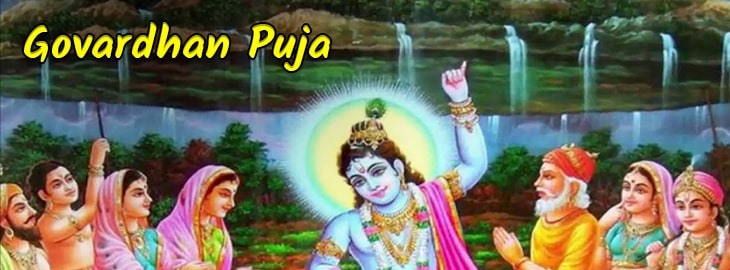Govardhan Pooja holds extreme significance in Hindu faith. These festivals exemplify the nature and the human beings. According to the Hindu calendar, Govardhan Pooja or Annakoot is commemorating on the 1st day of Shukla Paksha in the month of Kartik. This festival is celebrated throughout the country, but its spirit reaches acme in North India especially in the areas of Vraj Bhumi comprise of Mathura, Vrindavan, Nandgaon, Gokul, and Barsana. The above mention places are important with respect to the festival as here itself, Lord Krishna stimulate the people of Gokul for Govardhan Pooja and zapped the arrogance of Lord Indra.
Govardhan Puja Date and Scriptures
Govardhan Pooja is celebrated on the 1st day of Shukla Paksha in the month of Kartik and it can be deduced in the following way-
- Govardhan Pooja should be celebrated on the 1st day of bright half of the Hindu lunar month of Kartik. However, there’s a situation to it, as per the holy texts, the moon should not rise at night within the given time period of Puja Muhurat.
- If on the 1st day of bright half of the Hindu lunar month of Kartik at the time of sunset, there is a chance that Moon would raise then Govardhan pooja should be done on the day before.
- If at the time of sunrise Pratipada date prevail and there is no sign of Moon rise then, Govardhan Pooja should be celebrated on the very same day. And if it is not so, then Govardhan Pooja should be done on the previous day.
- When Pratipada date prevails up to 9 Muhurat after the sunrise no matter there is a moon rise in the evening but there should be a non existence of complete moon rise. In this situation Govardhan Pooja should be celebrated on the same day.
Govardhan Puja Rules and Procedure
Govardhan Pooja is very important in the life of the people of India. There is also a belief of worshiping Lord Varuna, Indra and Agni on this exacting day. On this day, Govardhan Parvat, Godhan indicating cow and Lord Krishna holds entire significance. These festivals declare us a message that human life is largely dependent on the basic elements and resources of nature and hence, we should be grateful and thankful to our Mother Nature. It is Govardhan Pooja, through which we express our respect towards the natural resources which we procure.
- On the day of Govardhan Pooja, Govardhan made from cow dung is made and are decorated with flowers. Usually Govardhan Pooja is done either in the evening or in the morning. During the Pooja, water, fruits, incense sticks and oblation are offered to Govardhan. Also on this very day, cow-bull and animals used for farming purposes are also worshiped.
- An effigy of Govardhan Ji is made from cow dung on the ground and a clay lamp is placed on the naval. Put milk, curd, Gangajal, honey, crystallized sugar (bataashe) in the lamp during the pooja occasion and after that Prasad is dispersed.
- After the puja, everyone hails for Govardhan Ji while revolving around the idol. While doing this, water from a vessel is made to spill and the revolution is completed by sowing the barley on the ground.
- Govardhan Giri is known as a form of God and worshiping him on this day strengthen you financially, favorable for the improvement of children, and for ornamental the cow milk.
- On the day of Govardhan Pooja, Lord Vishwakarma is also worshiped. On this time, Machines are also worshiped in the factories and industries.
Govardhan Puja Ceremonies
- The festival of Govardhan Pooja is a devotion to nature and Lord Krishna. On this time spiritual ceremonies and bhandara (a feast for all) are organized in the temples throughout the country. After the pooja, food is dispersed among the people as Prasad.
- Rotating around Govardhan Parvat on this day of Govardhan Pooja has a significant thrust. It is assumed that by making the revolutions, blessings of Lord Krishna is seeked.
Legend behind Govardhan Puja
The importance of Govardhan Puja has been describe and elaborated in the Vishnu Purana. It is assumed that Lord Indra was high handed with his powers, so in order to shatter his arrogance; Lord Krishna came to the front. According to a myth, once people in Gokul were prepare various delicacies and were singing songs with great eagerness. Seeing this, BAL Krishna asked Maa Yashoda that for which opportunity people are making arrangements. Maa Yashoda answered that they are worshiping Lord Indra. Then, again Krishna asked Maa Yashoda that why they worship Lord Indra. Maa Yashoda answered that they receive a good downpour, fodder for cows and production of cereals by the grace of Lord Indra. On listening to his mother, Krishna said that if it is so then they should worship Govardhan Parvat because cows feed on the grasses and plants & trees form the reasons for good rainfall. People of Gokul decided to the Krishna’s context and they started the Pooja. On witnessing this, Lord Indra became angry and in order to avenge for his insult started torrential rains in Gokul. On seeing this heavy downpour, people of Gokul were scared and panic suffering. Then, Lord Krishna by exhibit his powers lifted the Govardhan Parvat on his little finger and made the people of Gokul to come beneath the Govardhan Parvat. Observing this, Lord Indra made rain more and heavier, but even after 7 continuous days of extreme rainfall people of Gokul were safe enough. Then, Lord Indra realized that the person confront him is not a normal person. When Lord Indra exposed that he was challenging Lord Krishna, then Lord Indra apologized to Lord Krishna and he himself worshiped Lord Krishna. This is how began the worship and the essence of Govardhan Parvat.
On the day of Govardhan Pooja, revolution around the Govardhan Parvat is very important. Govardhan Parvat is located in Mathura district of Uttar Pradesh where every year lakhs of devotees visit there to make revolutions around the Govardhan Parvat.
Annakoot for Govardhan Puja
On the time of Govardhan Pooja, Annakoot is organized in the temples. Annakoot means mixture of various grains which is used as an offering for Lord Krishna in order to worship him. At some places, khichdi of pearl millet is prepared and in addition to this Puri is also prepared. Together with Annakoot, sweets made from milk and various delicacies are ready to offer as ‘Bhog’ to Lord Krishna. After the Pooja, these delicacies are dispersed among the devotees. In various temples, the during the time of Annakoot all night vigil, songs & dance is also perform and a successful life is yearned by the love of Lord Krishna.



